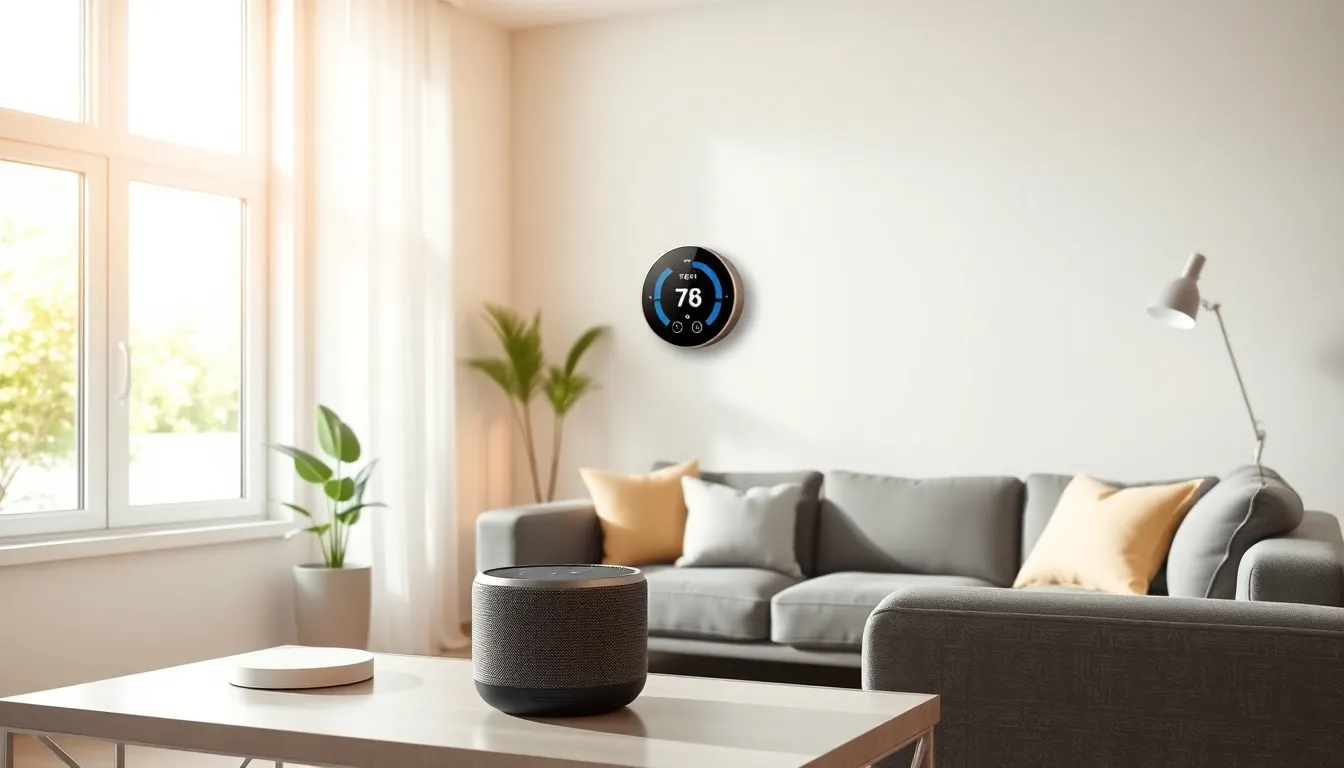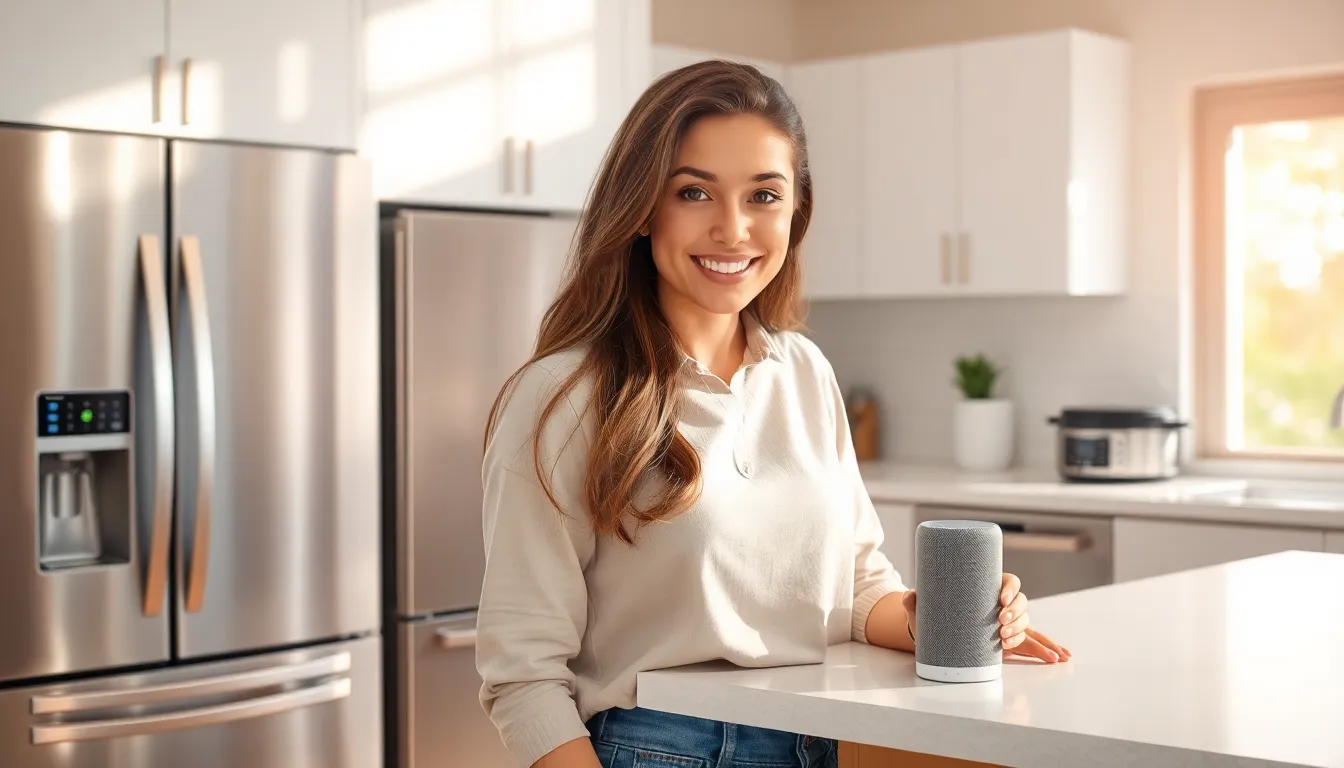Imagine walking into your home and having it greet you like an old friend. With a smart home upgrade, that dream can become a reality. Gone are the days of fumbling for light switches or cranking up the thermostat like it’s a vintage radio. Today’s technology transforms ordinary houses into intelligent living spaces that cater to your every whim—like a butler who never takes a day off.
Table of Contents
ToggleWhat Is a Smart Home Upgrade?
A smart home upgrade incorporates advanced technology to enhance residential living. These upgrades involve interconnected devices that improve home functionality and comfort. Home automation systems allow users to control lights, heating, security cameras, and appliances remotely.
These upgrades often include devices like smart thermostats, which optimize energy usage while maintaining desired temperatures. Smart security systems provide real-time alerts and monitoring, ensuring safety and peace of mind. Voice-activated speakers enable convenient control over various smart home devices through simple commands.
Integrating smart lighting systems enhances ambiance while promoting energy efficiency. Users can easily set schedules or adjust brightness levels based on activities throughout the day. Smart home technology responds to preferences, automating tasks that previously required manual intervention.
Installation of smart locks allows for remote access, providing added security and convenience. Homeowners can grant access to guests without being present, a useful feature for vacation rentals. Smart appliances, including refrigerators and ovens, increase efficiency and can even notify users of maintenance needs.
Supporting various platforms, smart home upgrades ensure seamless integration across devices, creating a cohesive experience. Interconnected technology simplifies day-to-day life, catering to specific needs with minimal effort. As technology continues to evolve, smart home upgrades remain at the forefront of modern living solutions.
Benefits of Smart Home Upgrades

Smart home upgrades deliver numerous advantages that enhance daily living. These benefits range from convenience and security to energy efficiency.
Increased Convenience
Smart home technology simplifies everyday tasks. Voice-activated controls allow individuals to manage devices without physical interaction. Automating lighting and climate control creates an environment tailored to personal preferences. Scheduling features enable users to set routines, adjusting home settings according to specific times. Wireless connectivity facilitates easy access to home systems from anywhere, making it easy to control lights, locks, and appliances from a smartphone. This level of convenience transforms mundane routines into seamless experiences.
Enhanced Security
Security features stand out among smart home upgrades. Smart security systems offer real-time alerts and surveillance capabilities, allowing homeowners to monitor their properties from anywhere. Smart locks provide remote access control, enhancing safety without compromising ease of use. Integration with security cameras enables individuals to view live or recorded footage on their devices, improving peace of mind. Environmental sensors can detect smoke or carbon monoxide, instantly notifying homeowners and emergency services if necessary. These systems create a safer living environment through advanced technology.
Energy Efficiency
Energy efficiency receives significant improvement through smart home upgrades. Smart thermostats optimize heating and cooling, reducing unnecessary energy consumption. Homeowners can track and adjust energy usage via mobile apps, gaining insight into their habits. Automated lighting systems adjust based on occupancy or natural light levels, resulting in lower electricity bills. Smart appliances enhance efficiency by operating only when energy costs are lowest. These upgrades contribute to sustainability efforts while saving money and resources, promoting a more eco-friendly lifestyle.
Key Components of a Smart Home Upgrade
A smart home upgrade includes various interconnected devices that enhance daily living. These components work together to provide convenience, security, and energy efficiency.
Smart Lighting Solutions
Smart lighting solutions allow users to control lighting remotely. Users can adjust brightness and color through mobile apps or voice commands. Automation routines make it possible to schedule lights to turn on or off at specific times. Many systems integrate with motion sensors, activating lights when someone enters a room. Energy efficiency is a significant benefit, as smart bulbs consume less electricity than traditional options. Popular brands include Philips Hue and LIFX, which offer customizable options for various preferences.
Home Automation Hubs
Home automation hubs serve as the central control point for smart devices. These hubs connect different technologies, enabling seamless communication between them. Notable hubs include Samsung SmartThings and Amazon Echo Plus. Users can manage devices across diverse brands from a single interface. Voice assistants, like Amazon Alexa and Google Assistant, often integrate with these hubs, allowing voice control over connected devices. Establishing a reliable home automation hub enhances the overall smart home experience.
Smart Security Devices
Smart security devices enhance home safety and provide peace of mind. Users can monitor their homes remotely through smart cameras and doorbell systems. Notifications alert homeowners to unusual activities, enabling them to respond quickly. Some systems include smart locks, allowing secure access management for guests. Integration with home automation hubs often improves functionalities, such as arming security systems automatically when leaving home. Popular brands include Ring and Arlo, known for their robust features and user-friendly interfaces.
Steps to Implement a Smart Home Upgrade
Implementing a smart home upgrade involves a series of methodical steps that ensure an efficient transition to advanced technology. Assessments, device selections, and installation techniques play crucial roles in this process.
Assessing Your Needs
Identifying specific requirements is vital when considering a smart home upgrade. Evaluate routines to determine which areas could benefit most from automation, like lighting, security, or heating. Engaging with family members can help uncover additional preferences and usage patterns. Prioritize the features that offer the greatest convenience and efficiency, such as energy savings or enhanced security. Assess existing infrastructure to understand compatibility with new devices. By gathering this information, homeowners can make informed decisions that align with their lifestyle and preferences.
Choosing the Right Devices
Selecting the appropriate devices streamlines the smart home upgrade process. Research popular brands known for reliability, such as Philips Hue for lighting and Nest for thermostats. Compare specifications and capabilities to determine which devices align with specific needs; for example, choose a smart lock that supports remote access if security is a priority. Look for devices that offer compatibility with existing systems, ensuring seamless integration within the home ecosystem. Reading customer reviews can provide insights into performance and durability, guiding effective purchasing decisions.
Installation Tips
Proper installation optimizes device functionality and ensures long-term satisfaction. Start by thoroughly reading instruction manuals for each device, as this provides valuable setup information. Consider creating a plan for device placement, focusing on areas with strong Wi-Fi coverage to maintain connectivity. Utilize professional installation services when necessary, particularly for complex devices like smart security systems. Take time to test each device after installation to ensure they work correctly and meet expectations. Keeping the manufacturer’s support contact information readily available can help resolve any issues that arise during the setup process.
Embracing smart home upgrades can significantly elevate the quality of everyday living. With a range of interconnected devices at their fingertips homeowners can enjoy enhanced convenience and security. The ability to automate tasks and manage home environments through intuitive technology not only saves time but also promotes energy efficiency.
As technology continues to evolve so do the possibilities for creating a truly intelligent home. By carefully assessing needs and selecting the right devices individuals can transform their living spaces into seamless, responsive environments. The journey toward a smarter home is not just about gadgets; it’s about enhancing lifestyle and fostering a sense of comfort and control.








